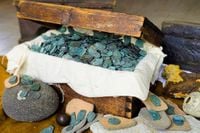In the sun-drenched shallows off Florida’s aptly named Treasure Coast, a team of modern-day treasure hunters has achieved what many thought was the stuff of legend. More than 1,000 gold and silver coins, valued at over $1 million, have been recovered from the infamous 1715 Spanish Treasure Fleet shipwreck, reigniting global fascination with one of maritime history’s most dramatic disasters.
The discovery, announced this week by 1715 Fleet – Queens Jewels, LLC, marks a rare and extraordinary chapter in the ongoing exploration of the Spanish Empire’s lost riches. The team, led by Captain Levin Shavers aboard the M/V Just Right, uncovered 1,051 silver "Reales" and five gold "Escudos" during the 2025 summer salvage season. These coins, minted in the Spanish colonies of Mexico, Peru, and Bolivia, bear clear mint dates and intricate seals—a numismatic time capsule from the early 18th century’s Golden Age.
"This discovery is not only about the treasure itself, but the stories it tells," said Sal Guttuso, director of operations for Queens Jewels, in a statement reported by multiple outlets, including TESAA and News-Press. "Each coin is a piece of history, a tangible link to the people who lived, worked, and sailed during the Golden Age of the Spanish Empire. Finding 1,000 of them in a single recovery is both rare and extraordinary."
The circumstances of the find are as compelling as the treasure itself. The coins were located near Ambersand Beach in north Indian River County, a stretch of coastline that has become synonymous with shipwreck lore. Many coins were found encrusted with remnants of a burlap sack, leading experts to believe they originated from a single chest—possibly one of several that broke apart during the fateful hurricane of 1715. "In the past, there’s evidence of them finding a chest which contained three burlap sacks and each sack had about 1,000 coins," Captain Shavers explained to News-Press. "We could potentially be looking at a chest of coins, and with there being two more thousand-coin dumps in the area."
The story behind these riches is as turbulent as the storm that doomed them. On July 31, 1715, a Spanish fleet carrying an estimated $400 million in gold, silver, and jewels set sail from Havana, only to be caught in a catastrophic hurricane off Florida’s coast. Eleven ships were lost to the sea, their precious cargo scattered across the ocean floor. Between 700 and 1,000 souls perished, while some 1,500 survivors struggled ashore, their ordeal etched into the annals of maritime tragedy.
For over three centuries, the sands and waters between Melbourne and Fort Pierce have drawn divers and dreamers alike. The 1715 fleet’s legacy has made Florida’s Treasure Coast a magnet for those seeking both fortune and historical insight. As TESAA reported, millions of dollars’ worth of coins and jewels have been recovered over the decades, each find adding a new piece to the puzzle of Spain’s colonial ambitions and the perilous Atlantic trade routes.
Yet, as Guttuso emphasized, this is more than just a hunt for gold. "This is not just a material treasure, but a piece of human history. Each coin tells a story: from its maker, to the one who transported it, and even the storm that buried it." The coins’ visible mint markings offer a rare opportunity for historians to decode the trade routes, tax systems, and economic intricacies of the Spanish colonial era. "Every find helps piece together the human story of the 1715 fleet," Guttuso said. "We are committed to preserving and studying these artifacts so future generations can appreciate their historical significance."
Strict regulations govern such discoveries. Under Florida law, all archaeological excavations are subject to oversight, and any unearthed treasures are considered state property. The state retains approximately 20% of the finds for scientific research and museum display, while the remaining 80% is divided among the salvage crews. Each excavation season is meticulously documented, and select coins undergo thorough legal review before being presented to the public. The coins from this latest haul will be conserved and cataloged before being submitted to the U.S. District Court for the Southern District of Florida, which administers maritime claims.
Queens Jewels, based in Sebastian—about 95 miles north of Palm Beach—operates under these tight guidelines, ensuring that both the letter and spirit of the law are followed. The company has announced plans to exhibit select pieces in local museums, offering residents and visitors a chance to connect with the area’s storied maritime past. "We are not just searching for gold, but digging into the memory of the ocean. Every dive carries a new promise... for the secrets have been buried under the sands for over 300 years," Guttuso reflected.
The last comparable discovery occurred in 1990, making this summer’s find all the more remarkable. The coins’ exceptional preservation, with many retaining their original mint marks and details, provides a rare window into the craftsmanship and economic networks of the era. For archaeologists and historians, such finds are invaluable—shedding light on the daily lives of sailors, the ambitions of empires, and the unpredictable power of nature.
But what draws so many to this particular patch of Florida’s coastline, year after year? Perhaps it’s the enduring allure of a mystery that refuses to be fully solved. The Treasure Coast, with its shifting sands and hidden wrecks, remains a living testament to both the dreams and disasters of those who came before. As Guttuso put it, "Every dive is a new promise." The ocean, it seems, still holds secrets waiting to be uncovered.
As the coins are cleaned, studied, and eventually displayed, both locals and visitors will have the chance to see, firsthand, the tangible remnants of a world lost to time but not to memory. The story of the 1715 fleet—its riches, its tragedy, and its enduring mystery—continues to unfold, one discovery at a time.
